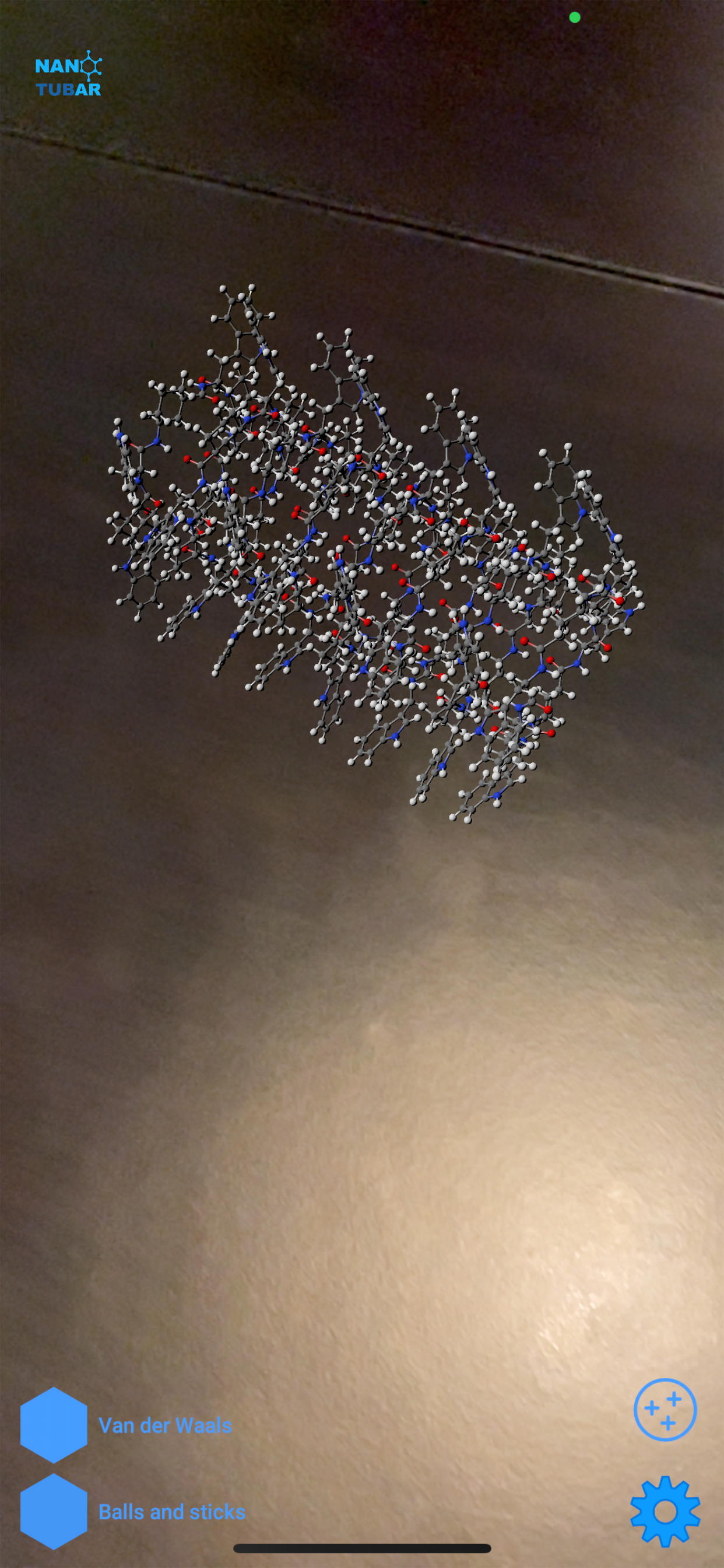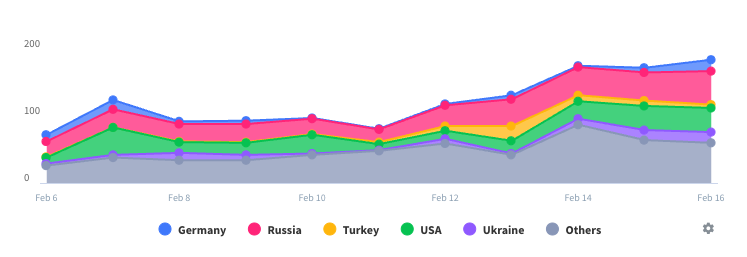
NanoTubAR
Veröffentlicht von: MD. USE INNOVATIONS SL
Downloads
Umsatz
Beschreibung
"Nanoscience" is the branch of science that is responsible for the study of objects at the nanometric scale, that is, those whose sizes are between 1 and 100 nm. One of the great challenges of nanotechnology is the preparation of new functional materials whose dimensions and structures are controlled at the molecular or atomic level. In chemistry, nanotubes are tubular (cylindrical) structures, with typical diameter sizes in the scale of a nanometer. There are nanotubes of many materials. Among the best-known are carbon nanotubes (CNT) made up of rolled sheets of carbon atoms, with physical and chemical properties that open the door to an immense horizon of applications. In addition to CNTs, there are nanotubes formed by the self-assembly of cyclic peptides. This type of nanostructures has attracted great attention from the scientific community in recent years due to their important applications in biology, chemistry and materials science. Much of this interest is related to its technological possibilities such as biosensors, photosensitive materials, antimicrobial agents, selective transport systems, molecular electronics and other potential uses in biology, electronics and optics.
The history of these nanotubes began in 1974, when De Santis predicted the formation of tubular structures by cyclic peptides, formed by alpha amino acids with alternating stereochemistry, D and L (D, L-α-CPs). However, it was not until 1993 when they were prepared in a laboratory thanks to Professor Ghadiri's group at Scripps. Their applications comprehend those that involve interaction with membranes, including the use as antimicrobials or as biomimetics of natural channels. Their hydrophilic internal cavity facilitates the transport of water and hydrophilic molecules of appropriate size, such as ions or drugs. The external properties of the nanotube are defined by the side chains of the amino acids that make up the cyclic peptide, oriented towards the outside. More recently, in the group of Prof. Juan R. Granja, at the University of Santiago de Compostela, nanotubes formed by cyclic peptides that alternate alpha amino acids with other types of artificial amino acids, such as gamma (α, γ-CPs) or delta (α, δ-CPs) have been designed and synthesized. This type of non-natural amino acids allows methylene groups to be introduced into the cavity of the channels, increasing their hydrophobicity and allowing their internal functionalization.
NanotubAR allows to visualize, using Augmented Reality technology, four types of nanotubes: a carbon nanotube (CNT) and three nanotubes formed by cyclic peptides. The representation of the nanotubes included in the app are not just cartoons, they come from realistic atomistic models resulting from computational simulations. In each of them, natural alpha amino acids (L-tryptophan) are combined with synthetic residues, such as D-tryptophan (D, L-alpha-CPs), gamma amino acids (alpha, gamma-CPs) and delta amino acids (alpha, delta -CPs). In all these designs, the amino and carbonyl groups of the amino acids are oriented perpendicularly to the plane of the cyclic peptides, with a suitable orientation to establish hydrogen bonds between the different units, and thus forming a tubular structure.
With NanotubAR it is possible to obtain a privileged view of these systems in our own home, or anywhere, from a simple texture, walk around it, and even enter its inner cavity to be able to observe its interior structure in detail at a level atomistic detail. In addition, NanotubAR allows changing the representation of the atoms that make up the systems and choosing between “ball and stick” or a van der Waals representation. Delve into nanotechnology and share with your friends a photo inside your favorite nanotube!
Ausblenden
Mehr anzeigen...
The history of these nanotubes began in 1974, when De Santis predicted the formation of tubular structures by cyclic peptides, formed by alpha amino acids with alternating stereochemistry, D and L (D, L-α-CPs). However, it was not until 1993 when they were prepared in a laboratory thanks to Professor Ghadiri's group at Scripps. Their applications comprehend those that involve interaction with membranes, including the use as antimicrobials or as biomimetics of natural channels. Their hydrophilic internal cavity facilitates the transport of water and hydrophilic molecules of appropriate size, such as ions or drugs. The external properties of the nanotube are defined by the side chains of the amino acids that make up the cyclic peptide, oriented towards the outside. More recently, in the group of Prof. Juan R. Granja, at the University of Santiago de Compostela, nanotubes formed by cyclic peptides that alternate alpha amino acids with other types of artificial amino acids, such as gamma (α, γ-CPs) or delta (α, δ-CPs) have been designed and synthesized. This type of non-natural amino acids allows methylene groups to be introduced into the cavity of the channels, increasing their hydrophobicity and allowing their internal functionalization.
NanotubAR allows to visualize, using Augmented Reality technology, four types of nanotubes: a carbon nanotube (CNT) and three nanotubes formed by cyclic peptides. The representation of the nanotubes included in the app are not just cartoons, they come from realistic atomistic models resulting from computational simulations. In each of them, natural alpha amino acids (L-tryptophan) are combined with synthetic residues, such as D-tryptophan (D, L-alpha-CPs), gamma amino acids (alpha, gamma-CPs) and delta amino acids (alpha, delta -CPs). In all these designs, the amino and carbonyl groups of the amino acids are oriented perpendicularly to the plane of the cyclic peptides, with a suitable orientation to establish hydrogen bonds between the different units, and thus forming a tubular structure.
With NanotubAR it is possible to obtain a privileged view of these systems in our own home, or anywhere, from a simple texture, walk around it, and even enter its inner cavity to be able to observe its interior structure in detail at a level atomistic detail. In addition, NanotubAR allows changing the representation of the atoms that make up the systems and choosing between “ball and stick” or a van der Waals representation. Delve into nanotechnology and share with your friends a photo inside your favorite nanotube!
Screenshots
NanoTubAR Häufige Fragen
-
Ist NanoTubAR kostenlos?
Ja, NanoTubAR ist komplett kostenlos und enthält keine In-App-Käufe oder Abonnements.
-
Ist NanoTubAR seriös?
Nicht genügend Bewertungen, um eine zuverlässige Einschätzung vorzunehmen. Die App benötigt mehr Nutzerfeedback.
Danke für die Stimme -
Wie viel kostet NanoTubAR?
NanoTubAR ist kostenlos.
-
Wie hoch ist der Umsatz von NanoTubAR?
Um geschätzte Einnahmen der NanoTubAR-App und weitere AppStore-Einblicke zu erhalten, können Sie sich bei der AppTail Mobile Analytics Platform anmelden.

Benutzerbewertung
Die App ist in Indonesien noch nicht bewertet.

Bewertungsverlauf
NanoTubAR Bewertungen
Keine Bewertungen in Indonesien
Die App hat noch keine Bewertungen in Indonesien.
Store-Rankings

Ranking-Verlauf
App-Ranking-Verlauf noch nicht verfügbar

Kategorien-Rankings
App ist noch nicht gerankt
NanoTubAR Konkurrenten
| Name | Downloads (30d) | Monatlicher Umsatz | Rezensionen | Bewertungen | Letzte Veröffentlichung | |
|---|---|---|---|---|---|---|
|
Visualizing Organic Chemistry
Make Organic Chemistry Dynamic
|
Freischalten
|
Freischalten
|
0
|
|
vor 1 Jahr | |
|
Turning Genes into Medicine
An Educational AR Experience
|
Freischalten
|
Freischalten
|
0
|
|
vor 1 Jahr | |
|
Experimental Organic Chemistry
|
Freischalten
|
Freischalten
|
0
|
|
vor 2 Jahren | |
|
1HCSC
|
Freischalten
|
Freischalten
|
0
|
|
vor 9 Monaten | |
|
Steiner Tree
|
Freischalten
|
Freischalten
|
0
|
|
vor 2 Jahren | |
|
Strings Conferences
|
Freischalten
|
Freischalten
|
0
|
|
vor 4 Monaten | |
|
PocketMDS
|
Freischalten
|
Freischalten
|
0
|
|
vor 2 Jahren | |
|
CrystalAspect
|
Freischalten
|
Freischalten
|
0
|
|
vor 1 Jahr | |
|
MacromoleculAR
|
Freischalten
|
Freischalten
|
0
|
|
vor 1 Jahr | |
|
Bernstein-Vazirani algorithm
quantum circuit for everyone!
|
Freischalten
|
Freischalten
|
0
|
|
vor 1 Jahr |
NanoTubAR Installationen
Letzte 30 TageNanoTubAR Umsatz
Letzte 30 TageNanoTubAR Einnahmen und Downloads
Gewinnen Sie wertvolle Einblicke in die Leistung von NanoTubAR mit unserer Analytik.
Melden Sie sich jetzt an, um Zugriff auf Downloads, Einnahmen und mehr zu erhalten.
Melden Sie sich jetzt an, um Zugriff auf Downloads, Einnahmen und mehr zu erhalten.
App-Informationen
- Kategorie
- Education
- Herausgeber
- MD. USE INNOVATIONS SL
- Sprachen
- English
- Letzte Veröffentlichung
- 1.0 (vor 3 Jahren )
- Veröffentlicht am
- Feb 4, 2021 (vor 3 Jahren )
- Auch verfügbar in
- Spanien, Portugal, Japan, Südkorea, Kasachstan, Libanon, Nigeria, Niederlande, Norwegen, Peru, Philippinen, Indien, Rumänien, Saudi-Arabien, Schweden, Singapur, Türkei, Taiwan, Vereinigte Staaten, Vietnam, Südafrika, Deutschland, Österreich, Aserbaidschan, Brasilien, Kanada, Schweiz, Chile, China, Kolumbien, Tschechien, Italien, Algerien, Ecuador, Ägypten, Vereinigtes Königreich, Griechenland, Sonderverwaltungsregion Hongkong, Indonesien, Israel, Argentinien
- Zuletzt aktualisiert
- vor 1 Woche
- © 2024 AppTail.
- Unterstützung
- Privacy
- Terms
- All Apps






